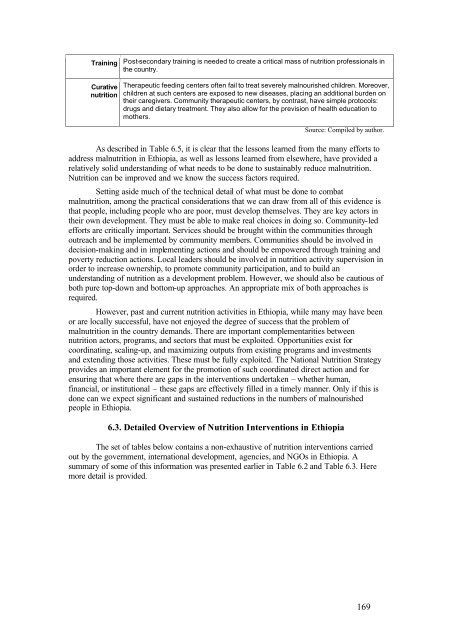An assessment of the causes of malnutrition in Ethiopia: A ...
An assessment of the causes of malnutrition in Ethiopia: A ...
An assessment of the causes of malnutrition in Ethiopia: A ...
Create successful ePaper yourself
Turn your PDF publications into a flip-book with our unique Google optimized e-Paper software.
Tra<strong>in</strong><strong>in</strong>g Post-secondary tra<strong>in</strong><strong>in</strong>g is needed to create a critical mass <strong>of</strong> nutrition pr<strong>of</strong>essionals <strong>in</strong><br />
<strong>the</strong> country.<br />
Curative<br />
nutrition<br />
Therapeutic feed<strong>in</strong>g centers <strong>of</strong>ten fail to treat severely malnourished children. Moreover,<br />
children at such centers are exposed to new diseases, plac<strong>in</strong>g an additional burden on<br />
<strong>the</strong>ir caregivers. Community <strong>the</strong>rapeutic centers, by contrast, have simple protocols:<br />
drugs and dietary treatment. They also allow for <strong>the</strong> prevision <strong>of</strong> health education to<br />
mo<strong>the</strong>rs.<br />
Source: Compiled by author.<br />
As described <strong>in</strong> Table 6.5, it is clear that <strong>the</strong> lessons learned from <strong>the</strong> many efforts to<br />
address <strong>malnutrition</strong> <strong>in</strong> <strong>Ethiopia</strong>, as well as lessons learned from elsewhere, have provided a<br />
relatively solid understand<strong>in</strong>g <strong>of</strong> what needs to be done to susta<strong>in</strong>ably reduce <strong>malnutrition</strong>.<br />
Nutrition can be improved and we know <strong>the</strong> success factors required.<br />
Sett<strong>in</strong>g aside much <strong>of</strong> <strong>the</strong> technical detail <strong>of</strong> what must be done to combat<br />
<strong>malnutrition</strong>, among <strong>the</strong> practical considerations that we can draw from all <strong>of</strong> this evidence is<br />
that people, <strong>in</strong>clud<strong>in</strong>g people who are poor, must develop <strong>the</strong>mselves. They are key actors <strong>in</strong><br />
<strong>the</strong>ir own development. They must be able to make real choices <strong>in</strong> do<strong>in</strong>g so. Community-led<br />
efforts are critically important. Services should be brought with<strong>in</strong> <strong>the</strong> communities through<br />
outreach and be implemented by community members. Communities should be <strong>in</strong>volved <strong>in</strong><br />
decision-mak<strong>in</strong>g and <strong>in</strong> implement<strong>in</strong>g actions and should be empowered through tra<strong>in</strong><strong>in</strong>g and<br />
poverty reduction actions. Local leaders should be <strong>in</strong>volved <strong>in</strong> nutrition activity supervision <strong>in</strong><br />
order to <strong>in</strong>crease ownership, to promote community participation, and to build an<br />
understand<strong>in</strong>g <strong>of</strong> nutrition as a development problem. However, we should also be cautious <strong>of</strong><br />
both pure top-down and bottom-up approaches. <strong>An</strong> appropriate mix <strong>of</strong> both approaches is<br />
required.<br />
However, past and current nutrition activities <strong>in</strong> <strong>Ethiopia</strong>, while many may have been<br />
or are locally successful, have not enjoyed <strong>the</strong> degree <strong>of</strong> success that <strong>the</strong> problem <strong>of</strong><br />
<strong>malnutrition</strong> <strong>in</strong> <strong>the</strong> country demands. There are important complementarities between<br />
nutrition actors, programs, and sectors that must be exploited. Opportunities exist for<br />
coord<strong>in</strong>at<strong>in</strong>g, scal<strong>in</strong>g-up, and maximiz<strong>in</strong>g outputs from exist<strong>in</strong>g programs and <strong>in</strong>vestments<br />
and extend<strong>in</strong>g those activities. These must be fully exploited. The National Nutrition Strategy<br />
provides an important element for <strong>the</strong> promotion <strong>of</strong> such coord<strong>in</strong>ated direct action and for<br />
ensur<strong>in</strong>g that where <strong>the</strong>re are gaps <strong>in</strong> <strong>the</strong> <strong>in</strong>terventions undertaken – whe<strong>the</strong>r human,<br />
f<strong>in</strong>ancial, or <strong>in</strong>stitutional – <strong>the</strong>se gaps are effectively filled <strong>in</strong> a timely manner. Only if this is<br />
done can we expect significant and susta<strong>in</strong>ed reductions <strong>in</strong> <strong>the</strong> numbers <strong>of</strong> malnourished<br />
people <strong>in</strong> <strong>Ethiopia</strong>.<br />
6.3. Detailed Overview <strong>of</strong> Nutrition Interventions <strong>in</strong> <strong>Ethiopia</strong><br />
The set <strong>of</strong> tables below conta<strong>in</strong>s a non-exhaustive <strong>of</strong> nutrition <strong>in</strong>terventions carried<br />
out by <strong>the</strong> government, <strong>in</strong>ternational development, agencies, and NGOs <strong>in</strong> <strong>Ethiopia</strong>. A<br />
summary <strong>of</strong> some <strong>of</strong> this <strong>in</strong>formation was presented earlier <strong>in</strong> Table 6.2 and Table 6.3. Here<br />
more detail is provided.<br />
169
















